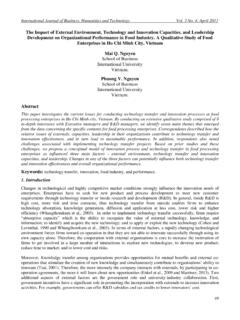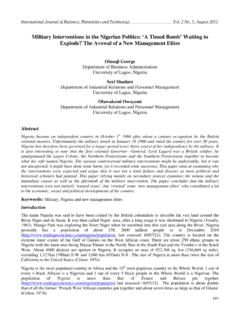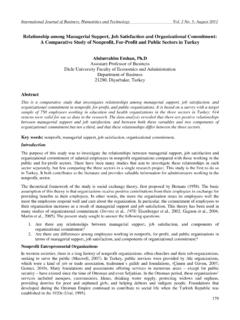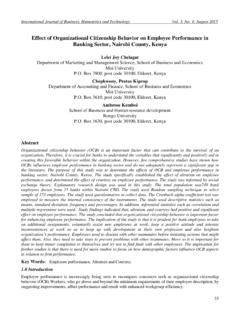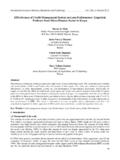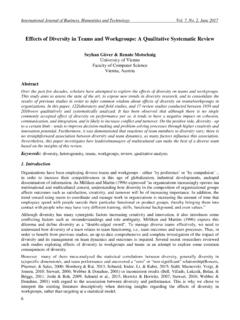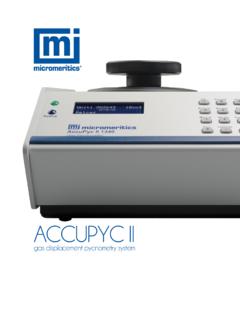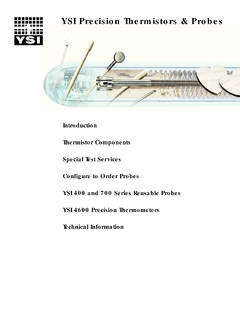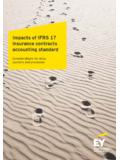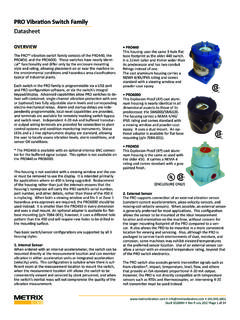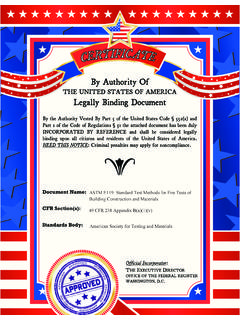Transcription of The Reward Strategy and Performance …
1 International Journal of Business, Humanities and Technology Vol. 2 No. 1; January 2012 211 The Reward Strategy and Performance measurement (Evidence from Malaysian Insurance Companies) Ong Tze San and Yip Mei Theen Faculty of Economics and Management University Putra Malaysia Malaysia Teh Boon Heng Lecturer Faculty of Management Multimedia University Malaysia Malaysia Abstract Purpose -- The purpose of this paper is to contribute to the body of knowledge in the area of Reward systems, particularly the total Reward framework. The Reward framework determined serve as the principal guideline for the small and medium enterprise in Malaysia. Design/methodology/approach -- The paper used an intensive case study of two selected insurance companies, known as Agency A and Company B.
2 The two companies are different in terms of their size and capital. Findings -- The findings suggest that the use of financial and objective measures are the main concern in designing the Reward systems of the organization, companies are gradually incorporated non-financial measures in their Reward systems. Other remarkable findings include identical rewards are tied to different working nature which is found to be deviate from the normal norms. Research limitation/implications The Reward framework identified can be used as guideline for the small and medium enterprises in Malaysia to further understand the function of Reward system, thus design and implement their unique and attractive Reward system. Originality/value The paper shows that rewards lead to increase in both financial and non-financial Performance which will also enhance companies reputation, as well as increase the recruitment possibility where more manpower will make a stronger team.
3 Effective rewards mechanism will shift from fulfilling employees basic requirement to self-actualization as they are growing with the business. Article Type: Research paper Keyword(s): Reward Strategy ; Total Rewards Approach; Financial Performance INTRODUCTION Rewards is one of the important elements to motivate employees for contributing their best effort to generate innovation ideas that lead to better business functionality and further improvise company Performance both financially and non-financially. Edward and Christopher (2006) have mentioned that people do not automatically come to work, continue to work, or work hard for an organization. We see that people need motivation to share and fulfill the organization s vision.
4 Undoubtedly, Reward Strategy and systems are the mechanisms that make this happen. Since 1980s, many research and studies have been done on the Reward aspect in other countries especially in the United State and China (Edward and Christopher, 2006; Lee and Wong, 2006; Paul, 1981; Sarin and Mahajan, 2001 and etc). However, few researchers in Malaysia have started to focus their study in this area. Do Malaysian companies agree that a Reward is able to motivate its employees and hence lead to an increase in the company s financial Performance ? What kind of Strategy that is often being used in Malaysia s companies? Since the Reward Strategy applied at different countries may vary due to the informal factors such as cultural insight or employee s preference, and may pose different outcome to the organization, it is essential for us to understand the Reward Strategy in the Malaysia context.
5 Centre for Promoting Ideas, USA 212 The objective of exploring the Reward Strategy and relationship justification on Reward system with financial Performance will then address the contribution of Reward Strategy in supplementing financial Performance of an organization and provide an informed view to others company executives on the Reward Strategy that can be implied on. LITERATURE REVIEW The practicing of Reward Strategy According to Armstrong (2000, ), Reward Strategy is the policy that provides specific directions for the organization to develop and design programmes which will ensure its rewards the Performance outcomes supporting the achievement of its business goals.
6 Vicki (1994) agreed that Reward Strategy gives specific direction to how the company will design its individual Reward programs. As defined by Gomez-Mejia and Balkin (1992) in Armstrong (2000, ), a Reward Strategy is: The deliberate utilization of the pay system as an essential integrating mechanism through which the efforts of various sub-units and individuals are directed toward the achievement of an organization s strategic objectives. Numerous studies have shown positive results on the effect of Reward structures on the Performance measure. Sarin and Mahajan (2001) came up with a few implications on how the rewards structure influence on the team Performance . The Performance dimensions which are not affected uniformly by the Reward structure should encourage the practitioners to reexamine some currently accepted theories and practices.
7 This indicates that suitable Reward Strategy development is indeed very important to each and every organization. Meanwhile, Lee and Wong (2006) have found that Reward does have an impact on the company s innovation Performance . In addition, Paul (1981) suggests that a Reward Strategy can point out the significant areas of an organization, and guiding its future orientation. Nowadays, a different and more flexible approach is needed in meeting changing lifestyles as well as the needs of today's young professionals (The Star, 2010). Recent trend as reported by Woods (2010) shows that the financial sector has changed the mix of pay, switches their Reward focus from short-term incentive schemes to long-term incentives scheme, according to a global survey by Mercer.
8 They are changing to focus more on balanced, risk-adjusted Performance measurement and deferral of bonus payouts over a multi-year timeframe. Also, according to a study released by Hay Group (2010), a global management consulting firm based in Philadelphia, the global recession and other macroeconomic trends in the global economy is prompting the businesses to change their Reward strategies. The Total Reward approach Total Reward could be used to manage and motivate people by thoroughly understanding the relative significance placed on the various aspects of the Reward proposition and applied the well-designed total Reward Strategy effectively. According to Armstrong and Stephens, (2006, ) total Reward is the combination of both the financial and non-financial rewards made available to the employees.
9 As defined by Manus and Graham in Armstrong and Stephens (2006, ), total Reward includes all type of rewards, direct and indirect, as well as intrinsic and extrinsic. Each aspect of rewards is being linked together as an integrated and rational whole. Meanwhile, WorldatWork (2007), a global human resources association in US with main focuses on compensation, benefits, work-life and integrated total rewards, has define total rewards as all of the tools available to the employer that may be used to attract, motivate and retain talented employees. It includes everything that the employee perceives to be of value in their employment relationship. Designing a total Reward Strategy that will ensure a well-integrated and cost-effective approach to compensate employees is possible.
10 The system built will ensure that the variable compensation costs is predictable and controllable, as well as employees have clear understanding about the connections between their efforts, productivity, and Performance results, and between company results and their Reward opportunities (Vicki, 1994). The theory basis of total Reward includes Maslow s need hierarchy theory, Alderfer s ERG theory; two-factor theory put forward by divides job-related factors into hygiene factors and motivators, Expectancy Theory, as well as Adams Equity Theory. The review of these related literature shows that when total Reward Strategy is to be adopted, it must assure that employees diverse needs must be well considered, and all these theory will help the organization reach its Performance expectation (Jiang, Xiao, Qi, Xiao, 2009).
